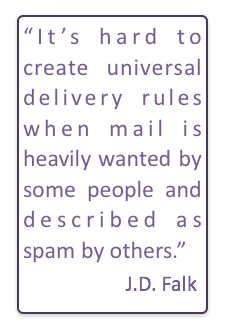Ip Addresses
Deliverability Help: Information checklist
When asking a for assistance with email delivery, there are some pieces of information that are required before anyone can help. Be prepared with the information so you can get timely assistance. This advice is true whether you’re looking for help from peers or working with paid deliverability consultants.
Read MoreDedicated IPs, pros and cons
There’s a whole belief system built around the idea that the best way to get good deliverability is to have your own dedicated IPs. In fact, senders regularly approach me to ask when is the right time for them to get a dedicated IP. They assume all their deliverability problems will disappear if they get a dedicated IP.
Read MoreFebruary 2017: The Month In Email
Happy March!
As always, I blogged about best practices with subscriptions, and shared a great example of subscription transparency that I received from The Guardian. I also wrote about what happens to the small pool of people who fail to complete a confirmed opt-in (or double opt-in) subscription process. While there are many reasons that someone might not complete that process, ultimately that person has not given permission to receive email, and marketers need to respect that. I revisited an older post on permission which is still entirely relevant.
Speaking of relevance, I wrote about seed lists, which can be useful, but — like all monitoring tools — should not be treated as infallible, just as part of a larger set of information we use to assess deliverability. Spamtraps are also valuable in that larger set of tools, and I looked at some of the myths and truths about how ISPs use them. I also shared some thoughts from an industry veteran on Gmail filtering.
On the topic of industry veterans, myths and truths, I looked at the “little bit right, little bit wrong” set of opinions in the world of email. It’s interesting to see the kinds of proclamations people make and how those line up against what we see in the world.
We attended M3AAWG, which is always a wonderful opportunity for us to catch up with smart people and look at the larger email ecosystem and how important our work on messaging infrastructure and policy really is. I was glad to see the 2017 Mary Litynski Award go to Mick Moran of Interpol for his tireless work fighting abuse and the exploitation of children online. I also wrote about how people keep wanting to quote ISP representatives on policy issues, and the origin of “Barry” as ISP spokesperson (we should really add “Betty” too…)
Steve took a turn as our guest columnist for “Ask Laura” this month with a terrific post on why ESPs need so many IP addresses. As always, we’d love to get more questions on all things email — please get in touch!
November 2016: The Month In Email
Happy December! Between #blackfriday, #cybermonday & #givingtuesday, pretty much everyone in the US has just survived a week of email from every brand and organization they’ve ever interacted with. Phew.
Is this still the best strategy for most senders? Maybe. But it’s always important to be adaptable and continue to evaluate and evolve your strategy as you move through the year.
As always, I continue to think about evolving our own strategies, and how we might best support senders and ESPs. One of the challenges we face when we talk to senders with deliverability questions is that so many of our answers fall into a nebulous “it depends” zone. We’re trying to articulate new ways to explain that to people, and to help them understand that the choices and details they specify at each point of their strategic planning and tactical execution have ramifications on their delivery. While “it depends” is still a correct answer, I’m going to try to avoid it going forward, and instead focus on exploring those choices and details with senders to help them improve deliverability.
In our community of deliverability and anti-abuse professionals, we are — as you’d expect — quite sensitive to unsolicited email that targets our industry. When an email circulates, even what seems like a reasonably well-thought-out email, it occasionally does not land well. Worse still are the various email-related product and service providers who try to legitimize B2B sales messaging as if it is something other than spam.
The takeaway from these discussions for senders is, as always: know your audience. This post about research from Litmus on millennials and spam is a great example of the kinds of things you might consider as you get to know your audience and how they prefer to communicate.
We also had a presidential election this month, one that made much of issues related to email, and it will be interesting to see how the candidates and parties use the email data they collected going forward.
In industry and security news, we saw over a million Google accounts breached by Android malware. We also saw some of the ramifications of a wildcard DNS entry from a domain name expiration — it’s an interesting “how things work” post if you’re curious. In other “how things work” news, we noted some of the recent changes AOL made to its FBL.
I answered an Ask Laura question about dedicated IP pools, and I have a few more queued up as well. As always, we want to know what questions are on the minds of our readers, so please feel free to send them over!
Spamhaus reports Verizon routing hijacked IPs
Late last week Spamhaus published a blog post detailing their investigation into Verizon routing millions of IP addresses hijacked by spammers.
The Spamhaus blog post goes into some detail about what hijacked routing is.
Deliverability and IP addresses
Almost 2 years ago I wrote a blog post titled The Death of IP Based Reputation. These days I’m even more sure that IP based reputation is well and truly dead for legitimate senders.
There are a lot of reasons for this continued change. 
Why do we "warmup" IP addresses
IP address warmup is a big issue for anyone moving to a new IP address for sending.
I’m constantly being asked how to warm up an IP. My answer is always the same. There’s no right way to warm up an IP nor is there a specific formula that everyone should follow.
What warming up is about is introducing mail traffic to receiving spam filters in a way that lets the filter know this is a legitimate email stream. This means sending small but regular amounts of mail that recipients interact with. As the filters adjust to the amount of mail from that IP, more mail can be sent over that IP. Increase the mail volume over the next few weeks until the desired volume is reached.
There are a couple things to remember about warming up.
Hunting the Human Representative
Yesterday’s post was inspired by a number of questions I’ve fielded recently from people in the email industry. Some were clients, some were colleagues on mailing lists, but in most cases they’d found a delivery issue that they couldn’t solve and were looking for the elusive Human Representative of an ISP.
There was a time when having a contact inside an ISP was almost required to have good delivery. ISPs didn’t have very transparent systems and SMTP rejection messages weren’t very helpful to a sender. Only a very few ISPs even had postmaster pages, and the information there wasn’t always helpful.
More recently that’s changed. It’s no longer required to have a good relationship at the ISPs to get inbox delivery. I can point to a number of reasons this is the case.
ISPs have figured out that providing postmaster pages and more information in rejection messages lowers the cost of dealing with senders. As the economy has struggled ISPs have had to cut back on staff, much like every other business out there. Supporting senders turned into a money and personnel sink that they just couldn’t afford any longer.
Another big issue is the improvement in filters and processing power. Filters that relied on IP addresses and IP reputation did so for mostly technical reasons. IP addresses are the one thing that spammers couldn’t forge (mostly) and checking them could be done quickly so as not to bottleneck mail delivery. But modern fast processors allow more complex information analysis in short periods of time. Not only does this mean more granular filters, but filters can also be more dynamic. Filters block mail, but also self resolve in some set period of time. People don’t need to babysit the filters because if sender behaviour improves, then the filters automatically notice and fall off.
Then we have authentication and the protocols now being layered on top of that. This is a technology that is benefiting everyone, but has been strongly influenced by the ISPs and employees of the ISPs. This permits ISPs to filter on more than just IP reputation, but to include specific domain reputations as well.
Another factor in the removal of the human is that there are a lot of dishonest people out there. Some of those dishonest people send mail. Some of them even found contacts inside the ISPs. Yes, there are some bad people who lied and cheated their way into filtering exceptions. These people were bad enough and caused enough problems for the ISPs and the ISP employees who were lied to that systems started to have fewer and fewer places a human could override the automatic decisions.
All of this contributes to the fact that the Human Representative is becoming a more and more elusive target. In a way that’s good, though; it levels the playing field and doesn’t give con artists and scammers better access to the inbox than honest people. It means that smaller senders have a chance to get mail to the inbox, and it means that fewer people have to make judgement calls about the filters and what mail is worthy or not. All mail is subject to the same conditions.
The Human Representative is endangered. And I think this is a good thing for email.
IP Address reputation primer
There has been a lot of recent discussion and questions about reputation, content and delivery. I started to answer some of them, and then realized there weren’t any basic reference documents I could refer to when explaining the interaction. So I decided to write some.
This first post is about IP address reputation with some background on why IPs are so important and why ISPs focus so heavily on the sending IP.
Yes, we have no IP addresses, we have no addresses today
We’ve just about run out of the Internet equivalent of a natural resource – IP addresses.
Read MoreMy ISP might get blacklisted
The last of seven in our occasional series on why ESPs need, or don’t need, lots of IP addresses to send mail properly.
Read MoreI want to avoid network outages
Number six of seven in our occasional series on why ESPs need, or don’t need, lots of IP addresses to send mail properly.
Read MoreI need to dodge filters
Number five of seven in our occasional series on why ESPs need, or don’t need, lots of IP addresses to send mail properly.
Read MoreI need to deliver my mail fast
Number four of seven in our occasional series on why ESPs need, or don’t need, lots of IP addresses to send mail properly.
Read MoreI need IP addresses to avoid throttling
Number three of seven in our occasional series on why ESPs need, or don’t need, lots of IP addresses to send mail properly.
Read MoreI need IP addresses to handle the volume
Number two of seven in our occasional series on why ESPs need, or don’t need, lots of IP addresses to send mail properly.
Read MoreI need IP addresses for reputation
Number one of seven in our occasional series on why ESPs need, or don’t need, lots of IP addresses to send mail properly.
Read MoreWhy do you need so many IP addresses (part 2)?
In my last post I discussed the background as to why an ISP will require their users to use their IP address allocation efficiently. I also mentioned in passing that I’d discussed ESP address allocation with both ESPs and ISPs recently.
The ESP was talking about assigning a couple of dozen IP addresses to each customer, because they might be useful for spreading load and it would provide some flexibility for moving from one IP address to another if one should get blocked. And IP addresses are pretty much free. They were wrong.
The ISP was considering an application for 750 IP addresses from a new ESP customer. They assumed that there was no possible reason other than snowshoe spam for an email related customer to need that many IP addresses. While I suspect they may have been right about the specific potential customer, the general assumption was wrong.
I’ve seen a lot of reasons given by ESPs for why they need so many IP addresses:

